Attached files
| file | filename |
|---|---|
| 8-K - 8-K - REGIONS FINANCIAL CORP | rf2018-09x12barclays.htm |
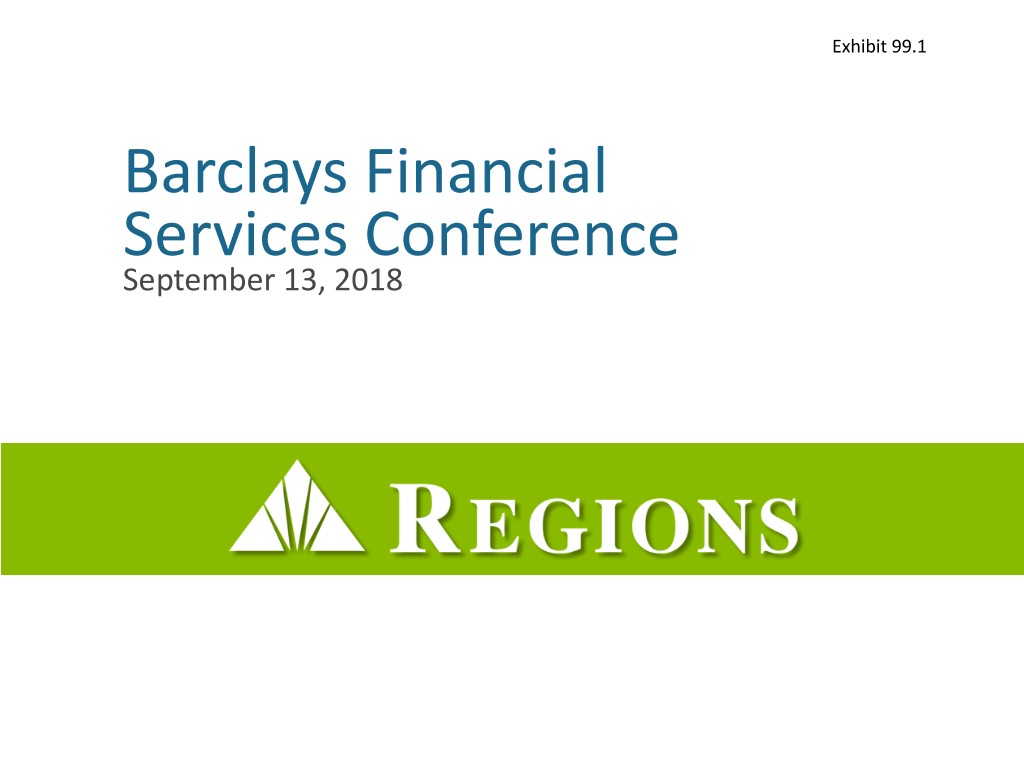
Exhibit 99.1 Barclays Financial Services Conference September 13, 2018

Managing for long-term performance Opportunities to drive growth and efficiencies Asset sensitivity Capital return Significant funding advantage Capital sufficient for organic driven by low-cost deposit growth, strategic opportunities, & base; accretive fixed-rate robust shareholder returns reinvestments Stable asset quality & Revenue growth & improved risk profile efficiency opportunities Broad-based credit metric Identify and execute additional improvements; sound risk opportunities to increase revenues management practices combined and reduce expenses through with recently completed de- risking activities have us positioned well for the next credit cycle 2
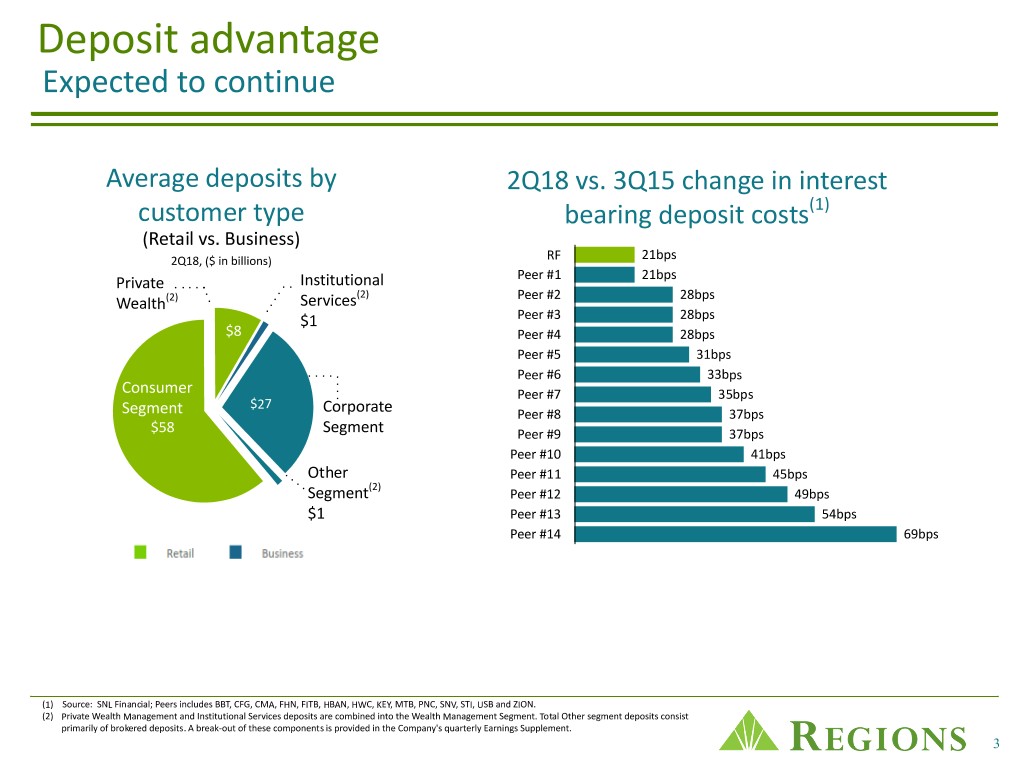
Deposit advantage Expected to continue Average deposits by 2Q18 vs. 3Q15 change in interest customer type bearing deposit costs(1) (Retail vs. Business) 2Q18, ($ in billions) RF 21bps Private Institutional Peer #1 21bps (2) Peer #2 28bps Wealth(2) Services $1 Peer #3 28bps $8 Peer #4 28bps Peer #5 31bps Peer #6 33bps Consumer Peer #7 35bps $27 Segment Corporate Peer #8 37bps $58 Segment Peer #9 37bps Peer #10 41bps Other Peer #11 45bps (2) Segment Peer #12 49bps $1 Peer #13 54bps Peer #14 69bps (1) Source: SNL Financial; Peers includes BBT, CFG, CMA, FHN, FITB, HBAN, HWC, KEY, MTB, PNC, SNV, STI, USB and ZION. (2) Private Wealth Management and Institutional Services deposits are combined into the Wealth Management Segment. Total Other segment deposits consist primarily of brokered deposits. A break-out of these components is provided in the Company's quarterly Earnings Supplement. 3

Deposit advantage Benefiting from high market share High market share(1) in core markets ($ in billions) Market Market • Top 5 or better market share in Top MSAs Deposits Rank Top MSAs Deposits Rank 70% of MSAs across 15-state (2) Birmingham, AL $11.2 1 Montgomery, AL $1.7 1 footprint Nashville, TN $7.6 2 Huntsville, AL $1.6 1 • Top 5 or better market share generally leads to outsized Tampa, FL $5.1 4 Chattanooga, TN $1.3 3 performance relative to branch Memphis, TN $4.2 2 Pensacola, FL $1.2 1 presence New Orleans, LA $3.1 4 Shreveport, LA $1.2 3 • Investing in priority markets Jackson, MS $3.0 2 Fairhope, AL $0.9 1 approaching a top 5 market share • Atlanta, GA Mobile, AL $2.3 1 Destin, FL $0.9 1 • St. Louis, MO Knoxville, TN $2.2 3 Tuscaloosa, AL $0.8 1 • ~70% of deposits in markets Baton Rouge, LA $1.9 4 Ocala, FL $0.7 4 without a significant money (3) Little Rock , AR $1.8 4 Kingsport, TN $0.6 1 center bank presence (1) MSA market rank based on FDIC deposit data as of 6/30/17 (2) Based on MSA and non-MSA counties using FDIC deposit data as of 6/30/17 (3) Significant money center bank presence (JPM, BAC, C, WFC) defined as combined market share using 6/30/17 FDIC deposit data of 4 20% or more

Asset quality & improved risk profile Criticized business loans NPLs and coverage ratio(1) ($ in millions) ($ in millions) $3,280 $2,962 $823 $760 1,162 $2,456 $650 941 $2,223 $601 $595 $1,908 1,007 925 144% 857 137% 140% 141% 2,118 2,021 127% 1,449 1,298 1,051 2Q17 3Q17 4Q17 1Q18 2Q18 2Q17 3Q17 4Q17 1Q18 2Q18 Classified Special mention Non-performing loans Coverage ratio • Non-performing, criticized, and troubled debt restructured loans, as well as total delinquencies, continue to improve • NPLs at lowest level since 2007 • Significant enhancements to credit risk infrastructure • Portfolio de-risking efforts substantially complete (1) Excludes loans held for sale 5
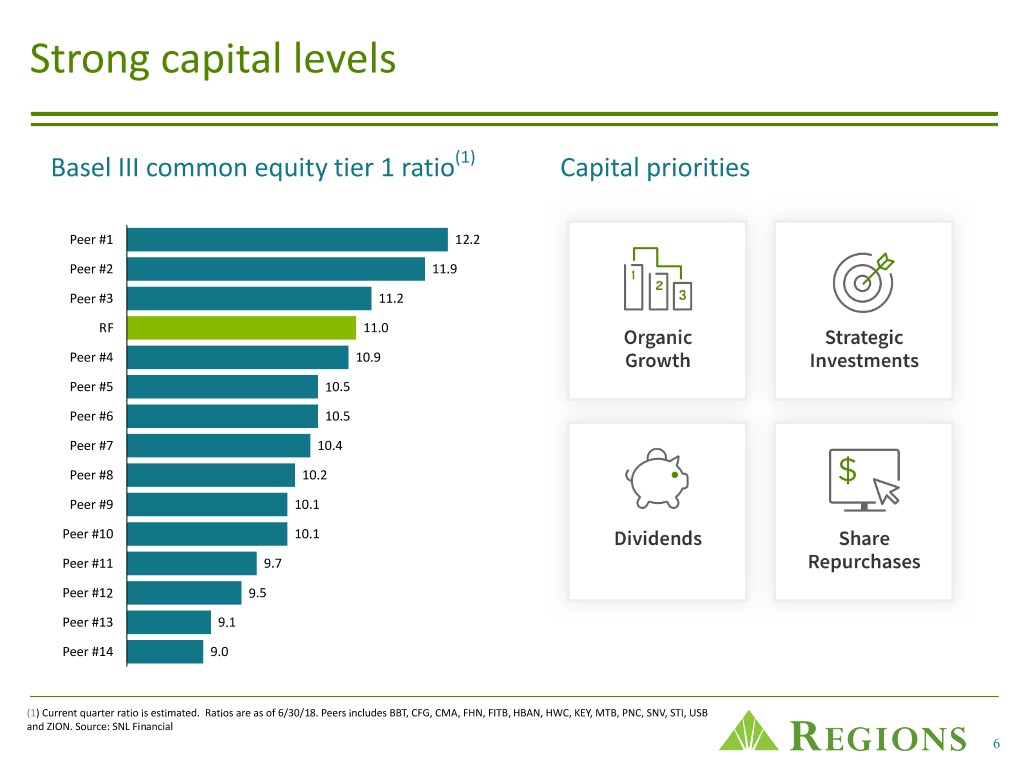
Strong capital levels Basel III common equity tier 1 ratio(1) Capital priorities Peer #1 12.2 Peer #2 11.9 Peer #3 11.2 RF 11.0 Peer #4 10.9 Peer #5 10.5 Peer #6 10.5 Peer #7 10.4 Peer #8 10.2 Peer #9 10.1 Peer #10 10.1 Peer #11 9.7 Peer #12 9.5 Peer #13 9.1 Peer #14 9.0 (1) Current quarter ratio is estimated. Ratios are as of 6/30/18. Peers includes BBT, CFG, CMA, FHN, FITB, HBAN, HWC, KEY, MTB, PNC, SNV, STI, USB and ZION. Source: SNL Financial 6

Simplify and Grow A continuous journey Making banking easier Organization simplification • Digitization • Organizational structure review • Loan process • Spans and layers review • Account opening • Streamline committees and decision • Streamline credit process; more making digital; faster response Revenue growth Efficiency improvements • Faster launch of new initiatives • Robotics and artificial intelligence • Advanced analytics to drive next • Shared services best customer offers • Branch and other facility • Channel optimization consolidations • Digitization • Outsourcing 7

Simplify and Grow: progress update A continuous journey Initial efficiency and revenue review ~ 40 initiatives underway aimed at.... Through the initial review making banking easier 30% opportunities identified represent ~70% expense growing revenue 70% savings and ~30% revenue improving efficiencies & growth opportunities effectiveness Accomplishments • Organizational changes to streamline • Sold $254 million of primarily TDR structure residential mortgage loans • Staffing (FTE-basis) down approximately • Streamlined risk governance while 1,100 positions YoY improving oversight and effectiveness • Closed sale of Regions Insurance • Refined retail network strategy 8

Simplify and Grow: investing for growth A continuous journey • Investing in talent and growth markets ◦ Hiring new bankers ◦ Adding talent in capital markets and digital banking ◦ Adding branches in targeted growth markets • Streamlining processes ◦ Accelerated commercial response time ~70% ◦ Digitization of consumer loan process • Investing in technology ◦ Rolled out Reggie, our virtual banker, in contact centers ◦ Enhanced ROSIE, our A.I. enabled branch assistant ◦ Systems upgrades in Commercial, Treasury Management & Wealth Management facilitating growth 9
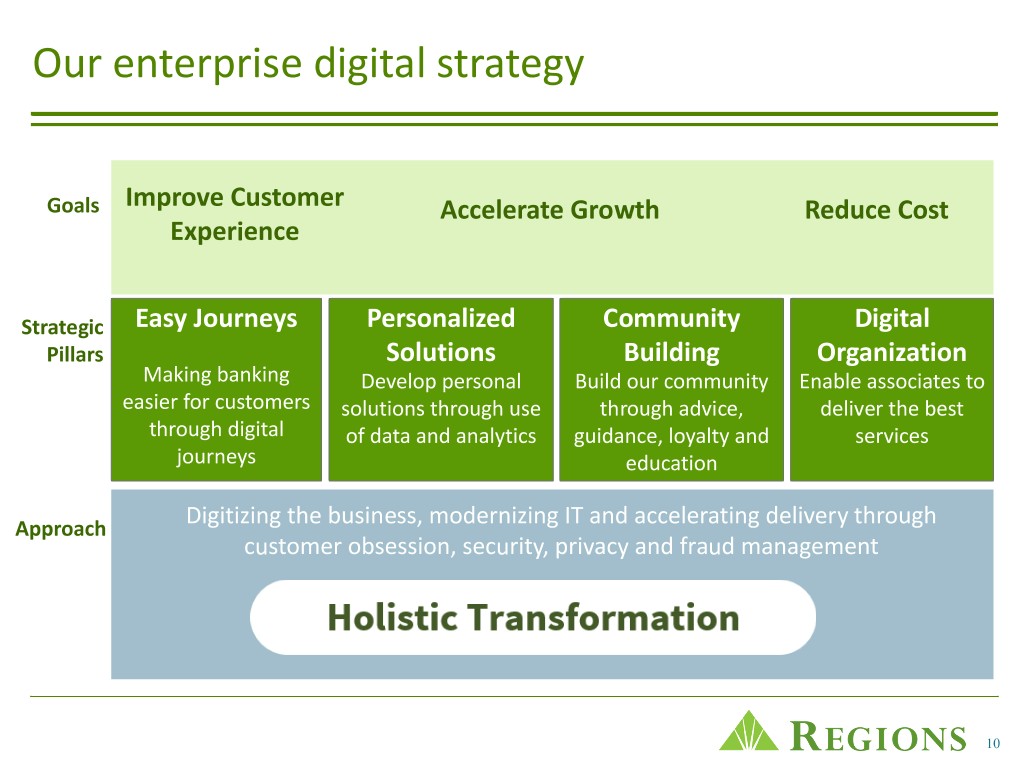
Our enterprise digital strategy Goals Improve Customer Accelerate Growth Reduce Cost Experience Strategic Easy Journeys Personalized Community Digital Pillars Solutions Building Organization Making banking Develop personal Build our community Enable associates to easier for customers solutions through use through advice, deliver the best through digital of data and analytics guidance, loyalty and services journeys education Digitizing the business, modernizing IT and accelerating delivery through Approach customer obsession, security, privacy and fraud management 10

Footprint positioning Characterized by high growth markets(1) ($ in Billions) ($ in Billions) '19-'24 Population Growth '19-'24 Population Growth Top MSAs Deposits Top MSAs Deposits 6.8% 6.1% Nashville, TN $7.6 Pensacola, FL $1.2 6.8% 6.9% Tampa, FL $5.1 Jacksonville, FL $1.0 6.6% 7.7% Miami, FL $4.2 Dallas, TX $1.0 6.5% 6.7% Atlanta, GA $3.7 Fairhope, AL $0.9 4.1% 7.5% Knoxville, TN $2.2 Destin, FL $0.9 8.1% 5.7% Orlando, FL $1.8 Ocala, FL $0.7 3.9% 4.5% Indianapolis, IN $1.7 Augusta, GA $0.6 4.5% 7.5% Huntsville, AL $1.6 Sarasota, FL $0.6 8.0% 5.8% Houston, TX $1.4 Panama City, FL $0.5 4.2% 8.5% Chattanooga, TN $1.3 Fort Myers, FL $0.5 National Average: 3.6% National Average: 3.6% (1) FDIC deposit data as of 6/30/17; population growth per SNL financial 11

Growing customer relationships Focused on fundamentals • Consumer checking accounts grew 1.2%(1) • Consumer NIB checking increased 6% and savings increased 8%(1) • Active consumer credit cards grew 7% and the penetration rate increased by 105 bps(1) • Wealth Management relationships grew 28%(1) • Total assets under supervision increased 1.2%(1) • New and renewed loan production increased 8%(1) • ~50% of consumer low cost deposits have been customers for over 10 years • Most common age of customers opening new consumer checking accounts is 18 years(2) • ~45% of new consumer checking accounts opened by customers younger than 30 years old(2) Increasing digital adoption • Over 55% of consumer checking customers utilize multiple channels • 75% of all interactions are through digital channels • Active online banking customers increased 4%(1) • Active mobile banking customers increased 12% and active mobile deposit customers more than doubled(1) (1) Represents year-over-year change as of June 30, 2018 (2) Based on 2017 new consumer checking account activity 12

2018 full-year expectations • Adjusted ROATCE of approximately 16%(1)(2) • Full-year adjusted average loans are expected to grow in the low single digits(1) • Full-year average deposits are expected to remain relatively stable, excluding brokered and Wealth Institutional Services deposits(3) • Adjusted operating leverage of approximately 3.5% - 4.5%(1) – Adjusted net interest income and other financing income growth (non-FTE) of 5% - 6%(1) – Adjusted non-interest income growth of 4.5% - 5.5%(1) – Adjusted non-interest expenses relatively stable(1) – Adjusted efficiency ratio < 60%(1) • Effective income tax rate of approximately 21% • Net charge-offs of 35-50 bps; based on recent performance and market conditions, expect to be at the lower end of the range (1) The reconciliation with respect to forward-looking non-GAAP measures is expected to be consistent with actual non-GAAP reconciliations included in attached appendix or previous filings with the SEC. (2) This long-term target was updated to reflect the impact of corporate income tax reform, and is measured on a continuing operations basis. (3) Private Wealth Management and Institutional Services deposits are combined into the Wealth Management Segment. Total Other segment deposits consists primarily of brokered deposits. A break-out of these components is provided in the Company's quarterly Earnings Supplement. 13

Forward-looking statements Forward-Looking Statements This release may include forward-looking statements as defined in the Private Securities Litigation Reform Act of 1995, which reflect Regions’ current views with respect to future events and financial performance. Forward-looking statements are not based on historical information, but rather are related to future operations, strategies, financial results or other developments. Forward-looking statements are based on management’s expectations as well as certain assumptions and estimates made by, and information available to, management at the time the statements are made. Those statements are based on general assumptions and are subject to various risks, uncertainties and other factors that may cause actual results to differ materially from the views, beliefs and projections expressed in such statements. These risks, uncertainties and other factors include, but are not limited to, those described below: • Current and future economic and market conditions in the United States generally or in the communities we serve, including the effects of possible declines in property values, increases in unemployment rates and potential reductions of economic growth, which may adversely affect our lending and other businesses and our financial results and conditions. • Possible changes in trade, monetary and fiscal policies of, and other activities undertaken by, governments, agencies, central banks and similar organizations, which could have a material adverse effect on our earnings. • The effects of a possible downgrade in the U.S. government’s sovereign credit rating or outlook, which could result in risks to us and general economic conditions that we are not able to predict. • Possible changes in market interest rates or capital markets could adversely affect our revenue and expense, the value of assets and obligations, and the availability and cost of capital and liquidity. • Any impairment of our goodwill or other intangibles, any repricing of assets, or any adjustment of valuation allowances on our deferred tax assets due to changes in law, adverse changes in the economic environment, declining operations of the reporting unit or other factors. • The effect of changes in tax laws, including the effect of Tax Reform and any future interpretations of or amendments to Tax Reform, which may impact our earnings, capital ratios and our ability to return capital to shareholders. • Possible changes in the creditworthiness of customers and the possible impairment of the collectability of loans and leases, including operating leases. • Changes in the speed of loan prepayments, loan origination and sale volumes, charge-offs, loan loss provisions or actual loan losses where our allowance for loan losses may not be adequate to cover our eventual losses. • Possible acceleration of prepayments on mortgage-backed securities due to low interest rates, and the related acceleration of premium amortization on those securities. • Loss of customer checking and savings account deposits as customers pursue other, higher-yield investments, which could increase our funding costs. • Possible changes in consumer and business spending and saving habits and the related effect on our ability to increase assets and to attract deposits, which could adversely affect our net income. • Our ability to effectively compete with other traditional and non-traditional financial services companies, some of whom possess greater financial resources than we do or are subject to different regulatory standards than we are. • Our inability to develop and gain acceptance from current and prospective customers for new products and services and the enhancement of existing products and services to meet customers’ needs and respond to emerging technological trends in a timely manner could have a negative impact on our revenue. • Our inability to keep pace with technological changes could result in losing business to competitors. • Changes in laws and regulations affecting our businesses, including legislation and regulations relating to bank products and services, as well as changes in the enforcement and interpretation of such laws and regulations by applicable governmental and self-regulatory agencies, which could require us to change certain business practices, increase compliance risk, reduce our revenue, impose additional costs on us, or otherwise negatively affect our businesses. • Our ability to obtain a regulatory non-objection (as part of the CCAR process or otherwise) to take certain capital actions, including paying dividends and any plans to increase common stock dividends, repurchase common stock under current or future programs, or redeem preferred stock or other regulatory capital instruments, may impact our ability to return capital to stockholders and market perceptions of us. • Our ability to comply with stress testing and capital planning requirements (as part of the CCAR process or otherwise) may continue to require a significant investment of our managerial resources due to the importance and intensity of such tests and requirements. • Our ability to comply with applicable capital and liquidity requirements (including, among other things, the Basel III capital standards and the LCR rule), including our ability to generate capital internally or raise capital on favorable terms, and if we fail to meet requirements, our financial condition could be negatively impacted. • The effects of any developments, changes or actions relating to any litigation or regulatory proceedings brought against us or any of our subsidiaries. • The costs, including possibly incurring fines, penalties, or other negative effects (including reputational harm) of any adverse judicial, administrative, or arbitral rulings or proceedings, regulatory enforcement actions, or other legal actions to which we or any of our subsidiaries are a party, and which may adversely affect our results. • Our ability to manage fluctuations in the value of assets and liabilities and off-balance sheet exposure so as to maintain sufficient capital and liquidity to support our business. 14

Forward-looking statements continued • Our ability to execute on our strategic and operational plans, including our ability to fully realize the financial and non-financial benefits relating to our strategic initiatives. • The risks and uncertainties related to our acquisition or divestiture of businesses. • The success of our marketing efforts in attracting and retaining customers. • Our ability to recruit and retain talented and experienced personnel to assist in the development, management and operation of our products and services may be affected by changes in laws and regulations in effect from time to time. • Fraud or misconduct by our customers, employees or business partners. • Any inaccurate or incomplete information provided to us by our customers or counterparties. • Inability of our framework to manage risks associated with our business such as credit risk and operational risk, including third-party vendors and other service providers, which could, among other things, result in a breach of operating or security systems as a result of a cyber attack or similar act or failure to deliver our services effectively. • Dependence on key suppliers or vendors to obtain equipment and other supplies for our business on acceptable terms. • The inability of our internal controls and procedures to prevent, detect or mitigate any material errors or fraudulent acts. • The effects of geopolitical instability, including wars, conflicts and terrorist attacks and the potential impact, directly or indirectly, on our businesses. • The effects of man-made and natural disasters, including fires, floods, droughts, tornadoes, hurricanes, and environmental damage, which may negatively affect our operations and/or our loan portfolios and increase our cost of conducting business. • Changes in commodity market prices and conditions could adversely affect the cash flows of our borrowers operating in industries that are impacted by changes in commodity prices (including businesses indirectly impacted by commodities prices such as businesses that transport commodities or manufacture equipment used in the production of commodities), which could impair their ability to service any loans outstanding to them and/or reduce demand for loans in those industries. • Our ability to identify and address cyber-security risks such as data security breaches, malware, “denial of service” attacks, “hacking” and identity theft, a failure of which could disrupt our business and result in the disclosure of and/or misuse or misappropriation of confidential or proprietary information, disruption or damage to our systems, increased costs, losses, or adverse effects to our reputation. • Our ability to realize our adjusted efficiency ratio target as part of our expense management initiatives. • Possible downgrades in our credit ratings or outlook could increase the costs of funding from capital markets. • The effects of problems encountered by other financial institutions that adversely affect us or the banking industry generally could require us to change certain business practices, reduce our revenue, impose additional costs on us, or otherwise negatively affect our businesses. • The effects of the failure of any component of our business infrastructure provided by a third party could disrupt our businesses, result in the disclosure of and/or misuse of confidential information or proprietary information, increase our costs, negatively affect our reputation, and cause losses. • Our ability to receive dividends from our subsidiaries could affect our liquidity and ability to pay dividends to stockholders. • Changes in accounting policies or procedures as may be required by the FASB or other regulatory agencies could materially affect how we report our financial results. • Other risks identified from time to time in reports that we file with the SEC. • Fluctuations in the price of our common stock and inability to complete stock repurchases in the time frame and/or on the terms anticipated. • The effects of any damage to our reputation resulting from developments related to any of the items identified above. The foregoing list of factors is not exhaustive. For discussion of these and other factors that may cause actual results to differ from expectations, look under the captions “Forward-Looking Statements” and “Risk Factors” of Regions’ Annual Report on Form 10- K for the year ended December 31, 2017 as filed with the SEC. The words "future," “anticipates,” "assumes," “intends,” “plans,” “seeks,” “believes,” "predicts," "potential," "objectives," “estimates,” “expects,” “targets,” “projects,” “outlook,” “forecast,” "would," “will,” “may,” “could,” “should,” “can,” and similar expressions often signify forward-looking statements. You should not place undue reliance on any forward-looking statements, which speak only as of the date made. We assume no obligation and do not intend to update or revise any forward-looking statements that are made from time to time. Regions’ Investor Relations contact is Dana Nolan at (205) 264-7040; Regions’ Media contact is Evelyn Mitchell at (205) 264-4551. 15
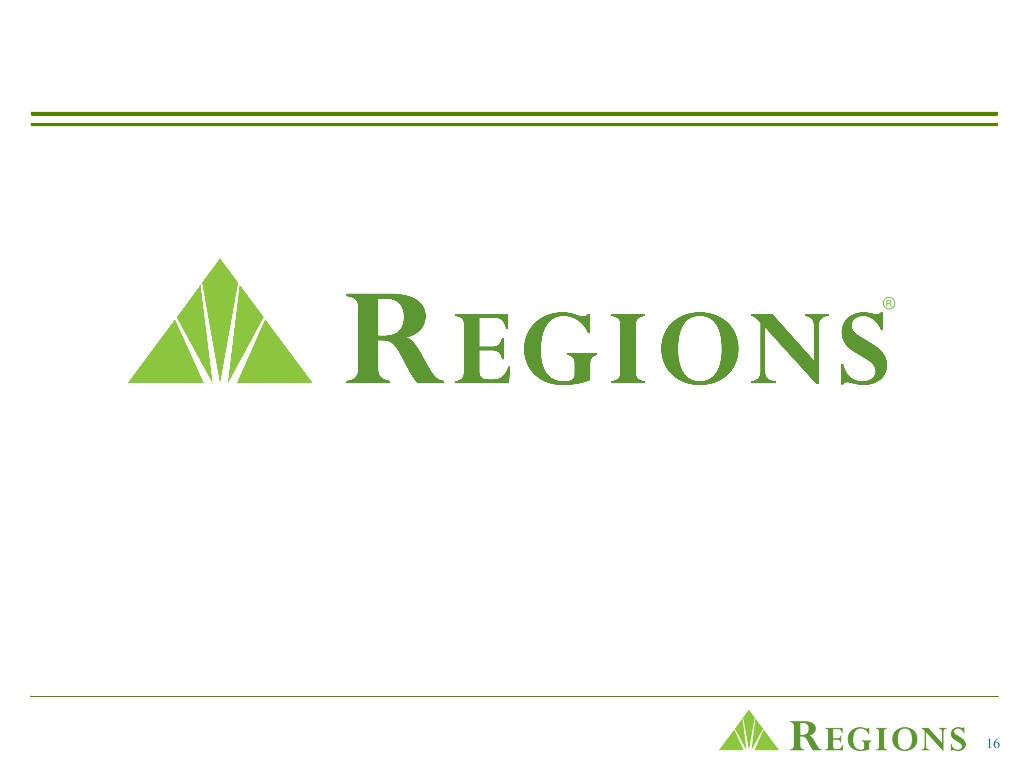
® 16
